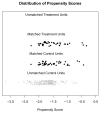Matching methods for causal inference: A review and a look forward
- PMID: 20871802
- PMCID: PMC2943670
- DOI: 10.1214/09-STS313
Matching methods for causal inference: A review and a look forward
Abstract
When estimating causal effects using observational data, it is desirable to replicate a randomized experiment as closely as possible by obtaining treated and control groups with similar covariate distributions. This goal can often be achieved by choosing well-matched samples of the original treated and control groups, thereby reducing bias due to the covariates. Since the 1970's, work on matching methods has examined how to best choose treated and control subjects for comparison. Matching methods are gaining popularity in fields such as economics, epidemiology, medicine, and political science. However, until now the literature and related advice has been scattered across disciplines. Researchers who are interested in using matching methods-or developing methods related to matching-do not have a single place to turn to learn about past and current research. This paper provides a structure for thinking about matching methods and guidance on their use, coalescing the existing research (both old and new) and providing a summary of where the literature on matching methods is now and where it should be headed.
Figures


References
-
- Abadie A, Imbens GW. Large sample properties of matching estimators for average treatment effects. Econometrica. 2006;74(1):235–267.
-
- Abadie A, Imbens GW. Bias corrected matching estimators for average treatment effects. Forthcoming in the Journal of Educational and Behavioral Statistics. 2009a. Available at www.hks.harvard.edu/fs/aabadie/bcm.pdf.
-
- Abadie A, Imbens GW. Working Paper 15301. National Bureau of Economic Research; Cambridge, MA: 2009b. Matching on the estimated propensity score.
-
- Agodini R, Dynarski M. Are experiments the only option? A look at dropout prevention programs. Review of Economics and Statistics. 2004;86(1):180–194.
-
- Althauser R, Rubin D. The computerized construction of a matched sample. American Journal of Sociology. 1970;76:325–346.
Grants and funding
LinkOut - more resources
Full Text Sources
Other Literature Sources
Medical
Miscellaneous
